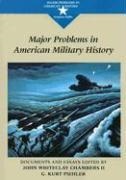Read more
Klappentext This volume traces the evolution of the American military! its institutions! strategic doctrines! and technology. The selections provide a social and institutional focus of the "new" military history! and follow the metamorphosis of the militia! the professionalization of the officers' corps! and the course of civilian control of the military. Note: Each chapter contains Further Reading. 1. Diverse Approaches to American Military History ESSAYS Russell F. Weigley, How Americans Wage War: The Evolution of National Strategy Richard H. Kohn, Exploring the Social History of the Military Alex Roland, Weapons and Technology Drive the American Military Dennis F. Showalter, The Importance of Battle History D'Ann Campbell, The Evolving Relationship of Women and Combat 2. The Colonial Era: Native American Versus European State Warfare DOCUMENTS 1. Governor John Winthrop Recounts the Killing of John Stone and the Treaty with the Pequots, 1634 2. Captain John Underhill Justifies the Attack on Mystic Village, in the Pequot War (1637), 1638 3. Captain John Mason Explains the Decision to Burn the Village (1637), 1638 4. William Apess, a Pequot, Later Denounces the Mystic Massacre (1637), 1831 5. Roger Williams Ponders the Self-Imposed Limitations of Indian Warfare, 1643 6. Colonel George Washington Praises the Virginia Provincial Troops, 1757 ESSAYS Francis Jennings, The Puritans Were the Savages Adam J. Hirsch, The Tragedy of Conflicting Military Cultures Don Higginbotham, A Different View of the Evolution of the Militia to the Continental Army 3. The American Revolution: Who Fought and Why? DOCUMENTS 1. Loyalist Peter Oliver Tells How an American Prisoner of War Justified His Enlistment to His Captors (1775), c. 1777-1781 2. General George Washington Explains His Strategy, 1777 3. Jeremiah Greenman, an Enlisted Man, Recounts the Bloody Battle of Monmouth, 1778 4. Private Joseph Martin Provides the Only Contemporary Account of "Molly Pitcher" (1778), 1830 5. A Militia Company Worries About Indians and Local Safety, 1781 6. Samuel Sutphin, a Black Slave, Tells of His Service in the Revolution (1781-1783) and His Freedom, 1834 7. Sarah Osborn, a Soldier's Wife, Relates How She Accompanied the Continental Army to Yorktown (1781), 1837 ESSAYS Mark E. Lender, Enlistment: Economic Opportunities for the Poor and Working Classes Charles Royster, Enlistment: Patriotic Belief in the Cause of Freedom Gregory T. Knouff, Enlistment: The Complexity of Motivations 4. The New Nation, the Military, and an American Way of War DOCUMENTS 1. The Articles of Confederation's Provisions on War and the Military, 1777 2. General George Washington Calls for a Standing Army, 1783 3. The Constitution's and Bill of Rights' Provisions on War and the Military, 1787, 1791 4. Antifederalists Fear a Large Military, 1787 5. Thomas Jefferson Advises an Economic Alternative to War, 1793 6. Alexander Hamilton Urges the Need for Defense and War, 1798 7. Andrew Jackson Proclaims War as a Crusade, 1812 ESSAYS John Shy, American Wars as Crusades for Total Victory Reginald C. Stuart, The Early Republic and Limited War 5. The Army, Professionalism, Jacksonian Democracy, and Manifest Destiny DOCUMENTS 1. President Andrew Jackson Calls for Removal of the Indians, 1830 2. From "Scarecrow Militia" to Volunteer National Guard Units: Contrasting Lithographs (1836, 1843) 3. First Lieutenant Joseph R. Smith Bemoans Lack of Civilian Respect, 1838 4. General Ethan Allen Hitchcock Agonizes over the Seminole and Mexican Wars, 1840-1848 5. Lieutenant William T. Sherman Disdains Politics, 1844 6. D. L. Goodall, a Tennessee Volunteer, Exults in the Battle of Monterrey, Mexico, 1846 7. Eliza Johnston, an Army Wife, Reports on an Expedition Through Indian Territory, 1855-1856 ESSAYS William B. Skelton, An Officer Corps Responds to an Undisciplined Society by Disciplined Professionalsim Robert E. May, An Officer Corps Responds to Opportunities for Expansion with I...
Summary
Designed to encourage critical thinking about history, the Major Problem in American History Series introduces students to both primary sources and analytical essays on important topics in US history. The text, designed to be the primary anthology - or even the textbook - of the course, covers the subject's chronological span.

